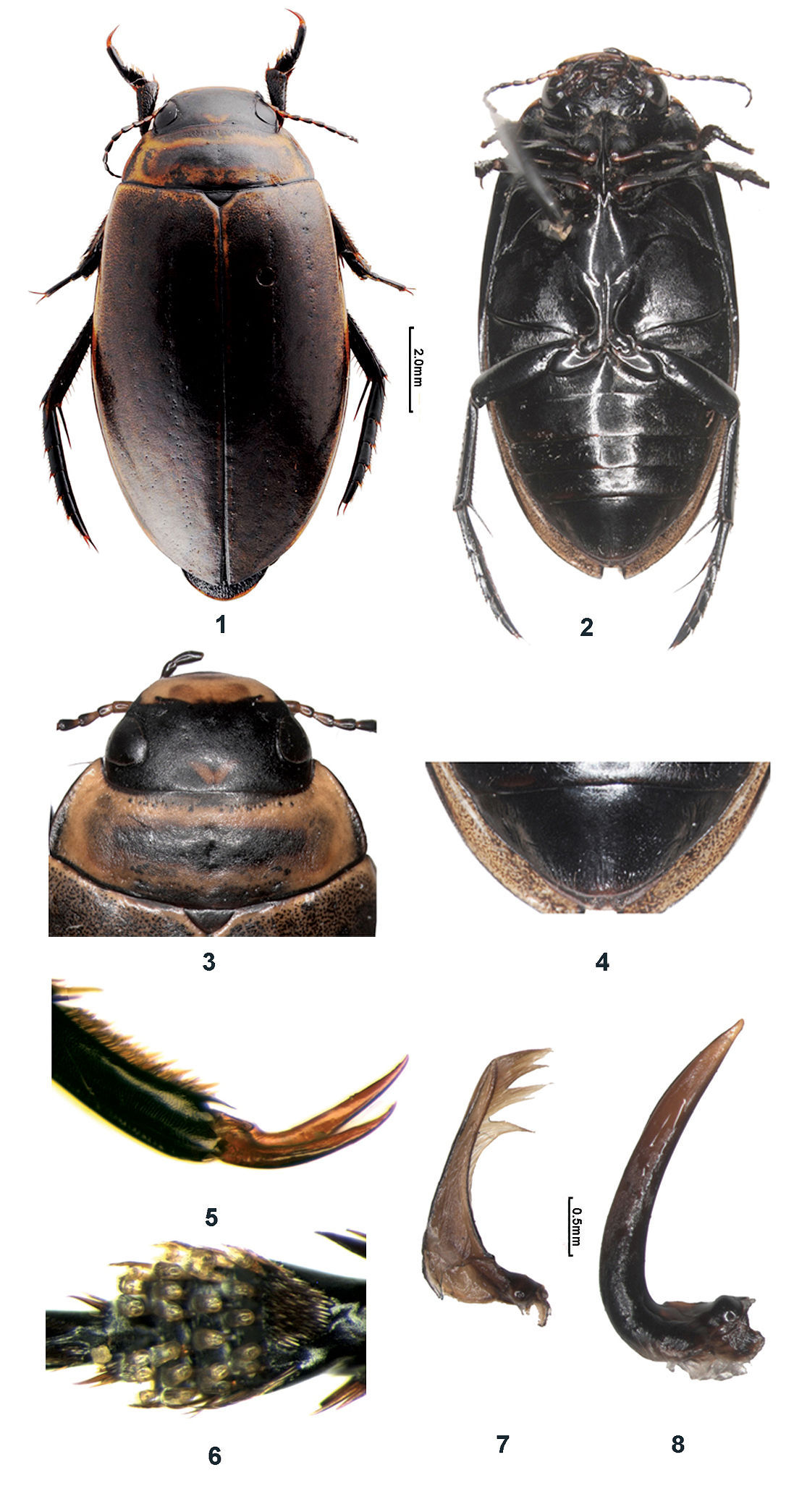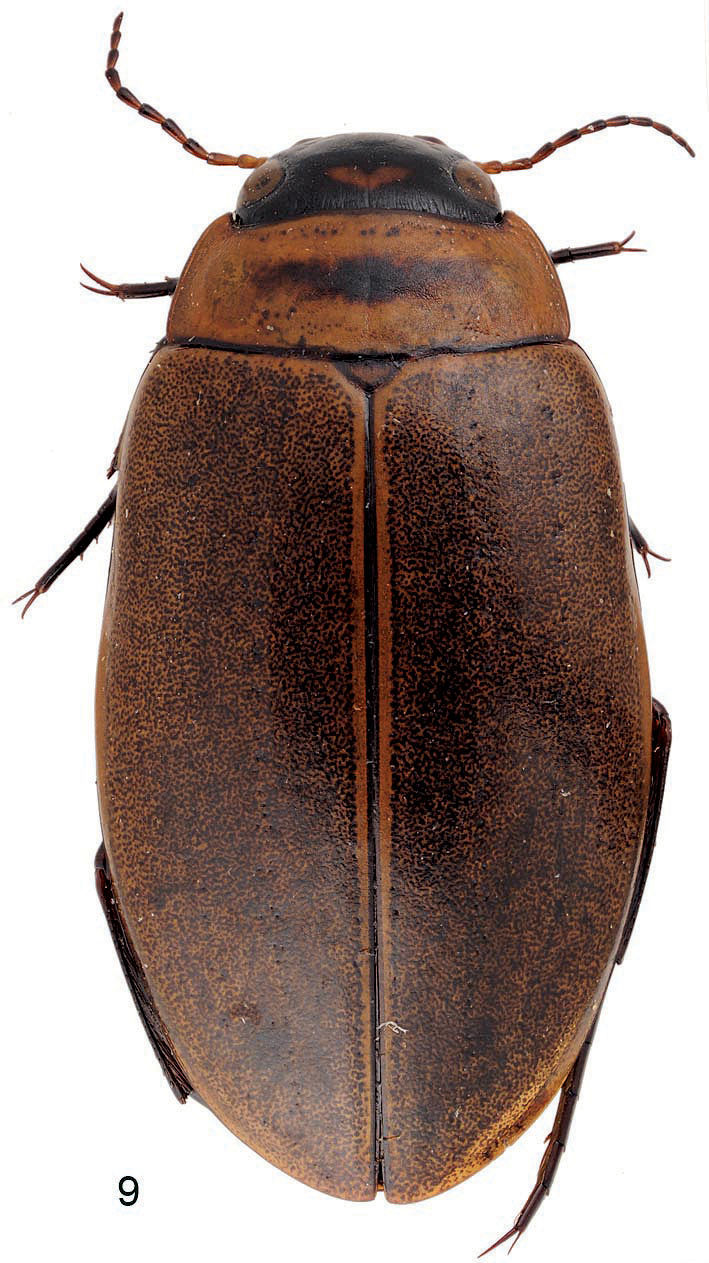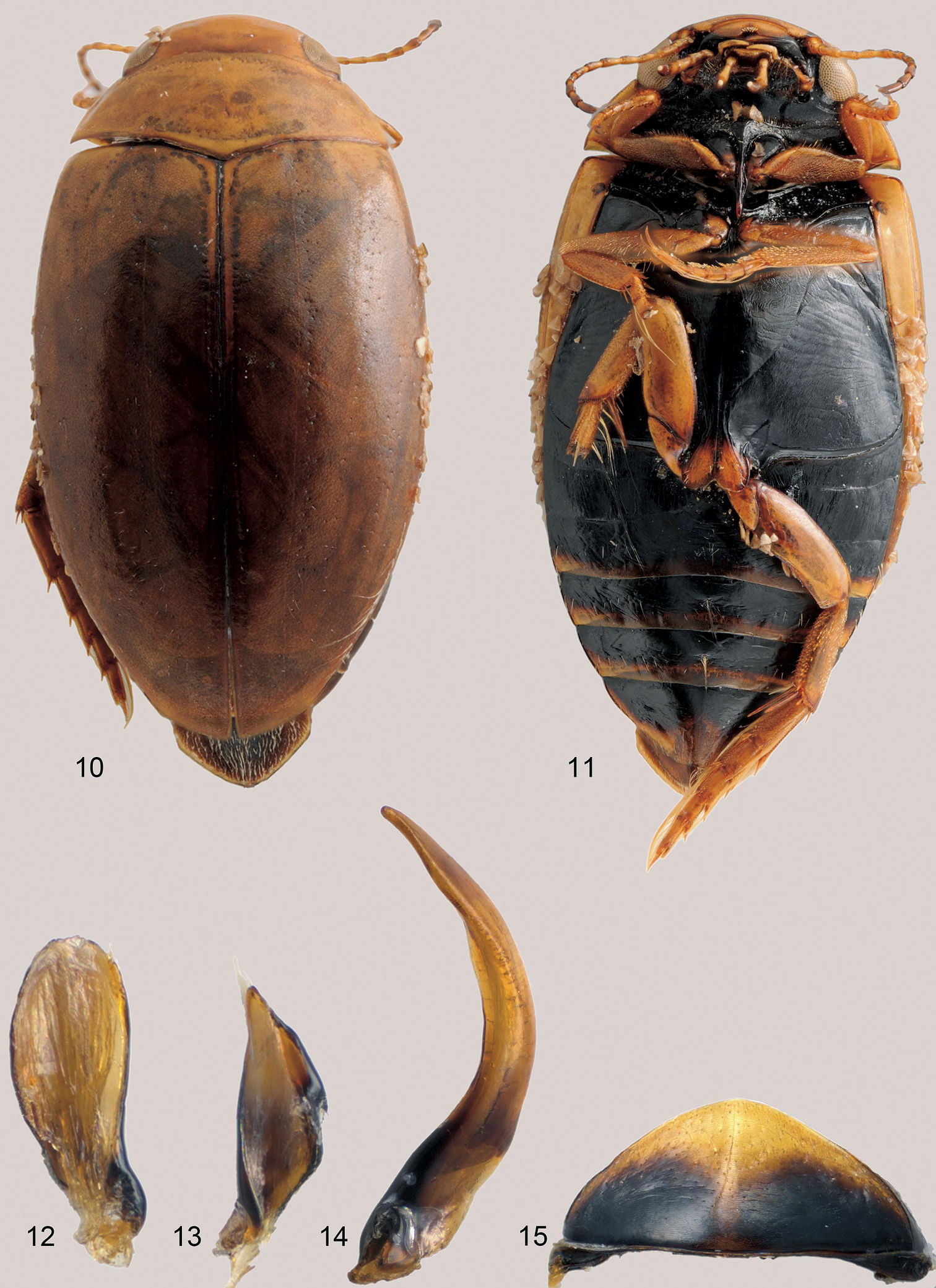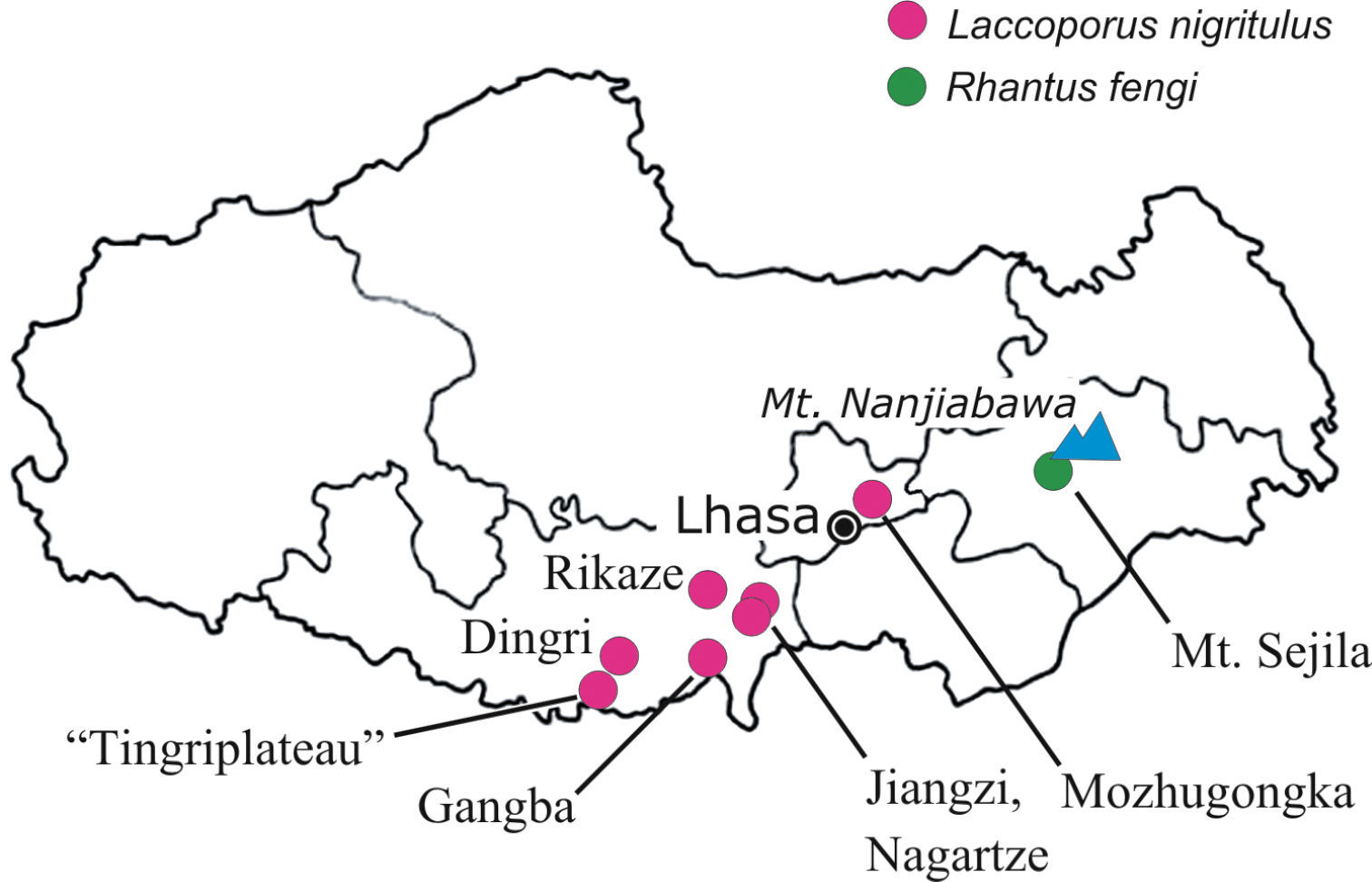(C) 2010 Shuang Zhao. This is an open access article distributed under the terms of the Creative Commons Attribution License, which permits unrestricted use, distribution, and reproduction in any medium, provided the original author and source are credited.
For reference, use of the paginated PDF or printed version of this article is recommended.
Rhantus fengi sp. n. from Mount Sejila, Xizang, China is described and illustrated. Laccoporus nigritulus (Gschwendtner, 1936) is redescribed and illustrated; Laccoporus viator Balfour-Browne, 1939, syn. n. is established as its junior subjective synonym.
China, Tibet, high altitude, Rhantus, Laccoporus, Dytiscidae, new species, new synonymy
Xizang Autonomous Region is one of the largest provinces
of China. The environment varies considerably with different elevation,
but rich aquatic resources such as natural lakes and wetlands are
abundant up to 5500 meters altitude. Yet, the diving beetle fauna of
Xizang remains comparably little known due to the inaccessibility of
many areas.
In 2009, the first two authors and Shuai Jiang collected a series of specimens of Rhantus Dejean, 1833 in Xizang, close to Mt. Nanjiabawa, which could not be assigned to any known species of the genus. This species is here described as new to science. In addition, the very rarely collected Laccoporus nigritulus (Gschwendtner, 1936) is redescribed based on specimens in the insect collection of Sun Yat-sen University (Guangzhou, Guangdong, China).
Material and methodsMorphological terminology largely follows Nilsson and Holmen (1995),
Codens
BMNH Natural History Museum, London, UK
CGC Collection of G. Challet, California, USA
CHF Collection H. Fery, Berlin, Germany; property of the Natural History Museum Vienna, Austria
MTD Museum für Tierkunde, Dresden, Germany
NMPC Národní Museum, Prague, Czech Republic
SYSU Sun Yat-sen University, Guangzhou, China
ZSM Zoological State Collection Munich, Germany
ZSIC Zoological Survey of India in Calcutta, India
Online ResourcesWe have created species pages for the species treated herein on Species ID (http://species-id.net/wiki/Main_Page) where we provide additional illustrations as well as high-resolution versions of the images used here.
Systematicsurn:lsid:zoobank.org:act:F0EC468E-CA7D-4A0C-B722-65A0616873FA
http://www.species-id.net/wiki/Rhantus_fengi
Figs 1–8China: Xizang, Mount Sejila, 29°37'N, 94°37'E.
Holotype ♂ CHINA: Xizang, Mount Sejila, altitude 4200 m, 16.viii.2009, leg. Fenglong Jia [translation; labeled in Chinese] (SYSU); Paratypes (47 exs): 12 exs, same data as holotype (SYSU; 3 exs in CGC; 2 exs in ZSM); 4 exs same data as holotype but 12.viii.2009 (SYSU); 7 exs same data as holotype but 15.viii.2009 (SYSU); 4 exs same data as holotype but 17.viii.2009 (SYSU); 4 exs same data as holotype but 18.viii.2009 (SYSU); 3 exs same data as holotype but 13.–15.viii.2009 (SYSU); 2 exs Xizang, Bayi Town, Biological Study Base of SYSU, altitude 4200 m, vii.–ix.2009, leg. Shuai Jiang (SYSU); 4 exs Xizang, Mount Sejila, altitude 4100 m, vi.2009, leg. Shuang Zhao (SYSU).
General appearance of beetle rather dark, epipleuron black.
Body elongate-oval (Fig. 1).
Body length 13.2–14.1 mm, width 6.2–6.5 mm.
Head black, with orange triangular mark on frons and contrasting yellow clypeus (Fig. 3). Scape and pedicel yellow, antennomeres 2–5 piceous with yellow base, antennomeres 6–11 piceous. Maxillary and labial palps piceous. Pronotum yellow to yellowish brown, with a wide transverse black medial maculation that not reaching anterior and posterior margin; anterior and posterior margins with black bands rather broad medially that become lighter laterally, sometimes becoming thin laterally, lateral margin black except anterior angle, near anterior and posterior margins usually with somewhat regular black spots. Elytra yellow to yellowish brown, disc with very dense black speckles giving elytra dark appearance; lateral margin, base of elytra and near suture with yellow band, suture black; epipleura black. Ventral surface and legs black (Fig. 2), trochanters with yellowish base, pro- and mesotarsal claws somewhat dark brown.
Head with irregular polygonal meshes and fine punctation; meshes rather elongated and punctures coarser behind posterior margins of eyes; along inner face of eye with series of coarse setiferous punctures. Pronotum with irregular polygonal meshes and fine punctuation; along anterior and posterior margins with rows of coarse punctures, interrupted posteromedially; lateral portion distinctly depressed, without microreticulation, with broad rim (or border) reaching anterior angle; posterior angle broadly rounded. Elytra with irregular polygonal meshes and fine microreticulation best visible laterally and posteriorly (at 50×); each elytron with five rows of coarse setiferous punctures being somewhat irregular except in row 1 (sutural row) and very regular row immediately along lateral margin; elytral disc with similar meshes and fine punctures as on pronotum, mircroreticulation faint, hardly visible. Metaventrite (“metasternal wings”) broad laterally. Metafemur without group of setae on posteroexternal angle. Pro- and mesotarsomeres with claws gently curved; outer protarsal claw slightly shorter than inner one (Fig. 5) and inner mesotarsal claw distinctly shorter than outer one; inner hindclaw twice as long as outer one. Abdominal ventrites 4 and 5 with a transverse rows of coarse setiferous punctures; ventrite 6 rugose with stronger punctures and setae laterally, more or less depressed and smooth posteromedially.
Abdominal ventrite 6 posteriorly emarginate, with fine wrinkles laterally. Pro- and mesotarsomeres 1–3 clearly expanded laterally, with four rows of stalked suction discs ventrally (Fig. 6). Number of discs per transverse row: 5 discs (on tarsomere 1) - 5 discs (second row on tarsomere 1) – 5 discs (on tarsomere 2) - 5 discs (on tarsomere 3). Parameres with dense and long setation, some setae distally trumpet-shaped (Fig. 7). Median lobe of aedeagus as in Fig. 8.
Abdominal ventrite 6 simply rounded posteriorly (Fig. 4), pro- and mesotarsomeres 1–3 not expanded laterally, without stalked suction discs.
Rhantus fengi sp. n. 1 habitus, dorsal view 2 habitus, ventral view 3 head and pronotum, dorsal view 4 ventral view of 6th ventrite 5 male protarsal claws 6 ventral view of male protarsomeres 1–4 7 right paramere, inner view 8 median lobe of aedeagus, lateral view.
The elytral sculpture of polygonal meshes and
microreticulation as well as the parameres with some trumpet shaped
setae, place this species in the Rhantus suturalis group (
Rhantus gogonensis habitus.
The species is named in honour of Hsiao-Tang Feng, a pioneer in the Chinese Dytiscidae studies.
Collected from a branch of a small stream with fine sand on bottom. The water of the stream was about 10–15 cm deep and slowly flowing.
This genus is very similar to Laccophilus Leach, 1815, with the major difference being presence of apically acute metatibial spurs in Laccoporus (apically bifid in Laccophilus). However, this character has been shown to be reversible in Laccophilus, even though rarely so (
Laccoporus viator Balfour-Browne, 1939: 104, by original designation.
http://www.species-id.net/wiki/Laccoporus_nigritulus
Figs 10–15Laccophilus apicicornis var. nigritulus: China: Tibet, Te-ring Gompa; Laccoporus viator: China: Tibet, Gyangtse.
Laccophilus apicicornis var. nigritulus: 10 syntypes, Te-ring Gompa. 14, 000 ft. Tibet (F.H. Stewart) in ZSIC [not studied].
Laccoporus viator: Holotype, „allotype” and 10 other paratypes in BMNH. We studied 2 ♂♂ paratypes labelled: „Co-type”, „Gyangtse. / 13, 000 ft. / June 1904. / Tibet Expedit. / H.J. Walton. / 1903–172.”, „Laccoporus / viator. B-B. / Co-type.”.
20 exs (SYSU): 2 ♂♂ CHINA: Xizang, Dingri (Tering), 4300 m, 2.vi.1974, leg. Xuezhong Zhang, Academia Sinica; 1 ♀ the same data as male; 1 ♀ Xizang, suburb of Rikaze, 3826 m, 20–23.vii.1986, leg. Geqiu Liang; 5 ♂♂, 3 ♀♀ Xizang, Rikaze, 3862 m, 4.viii.1986, leg. Geqiu Liang; 1 ♂ the same data as the former, with a label „Laccophilus indicus ?”; 4 ♂♂, 3 ♀♀ Xizang, Mozhugongka County, 7.viii.1986, leg. Geqiu Liang; 8 exs (MTD, NMPC, CHF) „Tibet, Yamtso-ufer bei / Nagartze, N28°58'31, 9 / E90°24'6, 0; 4450mNN; / 29.VII. 1998; leg. O.Jäger”, „Laccoporus nigritulus / (Gschwendtner) / Fery det. 1999"; 11 exs (MTD, CHF) „Tibet, Tingriebene / N28°34'39, 7/E86°36'52, 7; 4400 m / 3.-5.VIII. 1998, lg. Jäger“, „Laccoporus nigritulus / (Gschwendtner) / Fery det. 1999”.
Measurements. Length 4.5–5.0 mm, width 2.5–2.6 mm (paratypes of Laccoporus viator: length 4.5–4.8 mm, width 2.3–2.6 mm).
(Figs 10, 11, 15). Dorsum uniformly yellow brown. Head yellowish brown, with one short dark brown line near antennae. Antenna with antennomeres 1–4 and base of antennomeres 5–6 yellow brown, antennomeres 7–11 andapical parts of antennomeres 5–6 dark brown. Maxillary palpomeres yellow brown, apical palpomere apically dark. Labial palpomeres yellow brown, apical palpomere dark. Pronotum sometimes paler with darker median, anterior and posterior transverse bands. Elytra clearly darker than pronotum, but with the same color at base as pronotum. Ventral surface of head and thorax black. Abdomen black, ventrites 3–6 yellow brown along posterior margins (e.g. Fig. 15). Legs yellow brown with coxae black, posterior half of metacoxal process yellowstructures(see http://www.species-id.net/wiki/Laccoporus_nigritulus for high resolution images of surfaces). Head with surface sculpture consisting of small irregular polygonal meshes, with some sparse coarse and shallow punctures in posterior half. Meshes somewhat stronger on posterior portion. Clypeus with transverse series of large punctures present anteriorly. Labrum with very deep excavation, surface with short transverse meshes, anterior notch with dense and short white setae. Antenna filiform, not dilated. Pronotum more or less depressed laterally, without lateral bead, with small irregular polygonal meshes, sometimes very tiny punctures detectable. Posterior corner almost rectangular. Elytra with base as wide as posterior portion of pronotum, surface with irregular polygonal meshes in size and shape, sculpture more or less stronger than that on pronotum, tiny punctures very sparse and clearly detectable. Prosternal process thin and long, bisinuate in lateral view, almost reaching posterior margin of mesocoxae. Metaventrite medially with some coarse and strong punctures behind mesocoxae. Metacoxae and metasternum strongly and irregularly scratched, with dense longitudinal sculptures and sparse tiny punctures. Pro- and mesofemora with tuft of long setae at basal portion posteriorly. Metafemora with fine and dense sculpture and tiny punctures. Metatibia with inner spur longer than outer one. Pro- and mesotarsi smooth. Metatarsi smooth, with fine sculpture dorsally. First tarsomere of metatarsi almost as long as following two tarsomeres combined. Claws normally curved, protarsal claws longer than metatarsal claws. Metatarsomere 1 almost as long as metatarsomeres 2–3 combined. Claws regularly curved, proclaws longer than metaclaws.
Laccoporus nigritulus male 10 habitus, dorsal view 11 habitus, ventral view 12 left paramere 13 right paramere 14 median lobe of aedeagus, lateral view 15 ventral view of 6th ventrite.
Protarsus not dilated. Median lobe and parameres as in Figs 12–14.
China: Xizang.
Genus Laccoporus was erected by
The types of Laccoporus viator are from Gyangtse (Jiangzi). The types of Laccoporus nigritulus were collected from “Te-ring” (Dingri) and “Gompa” (Gangba). The distance between these sites is only about 100–120 km (Fig. 16). The two latter sites are not far (about 90–120 km respectively) from Rikaze where some of our newly studied specimens originate from. The altiude of these three sites is 3900–4300 m.
Xizang Autonomous Region, collecting localities of Rhantus fengi and Laccoporus nigritulus and notable geographic localities for orientation. Dingri = Te-ring (type locality of Laccoporus nigritulus); Gangba = Gompa; Jiangzi = Gyangtse (type locality of Laccoporus viator).
This work was supported by the National Key Technology R&D Program (2007BAI32B05, 2007BAI32B06) and DFG grant BA2152/7-1 to M. Balke. We thank Christine Taylor (London) for loan of BMNH type material and Mario Toledo (Parma, Italy), Jiri Hájek (Prague, Czech Republic) and Hans Fery (Berlin, Germany) for critically reading previous manuscript versions.










